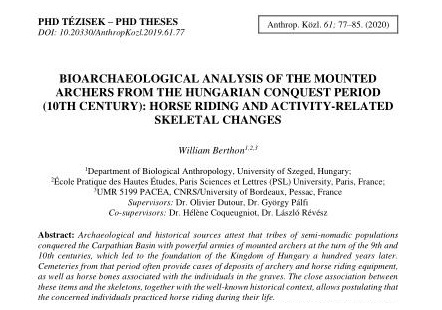Bioarchaeological analysis of the mounted archers from the Hungarian Conquest period (10th century): Horse riding and activity-related skeletal changes
Absztrakt
Archaeological and historical sources attest that tribes of semi-nomadic populations conquered the Carpathian Basin with powerful armies of mounted archers at the turn of the 9th and 10th centuries, which led to the foundation of the Kingdom of Hungary a hundred years later. Cemeteries from that period often provide cases of deposits of archery and horse riding equipment, as well as horse bones associated with the individuals in the graves. The close association between these items and the skeletons, together with the well-known historical context, allows postulating that the concerned individuals practiced horse riding during their life.
The doctoral research had two main objectives. The first one was to contribute to the research on activity reconstructions in past populations with the identification of skeletal changes that could more reliably be associated with the practice of horse riding, in particular. The second objective was to bring an ethnoarchaeological contribution by possibly improving our understanding of the societies from the Hungarian Conquest period and their funerary practices.
We selected a sample of 67 individuals from the 10th-century Hungarian cemetery of Sárrétudvari-Hízóföld, which was divided into two groups of individuals, according to the presence or absence of riding deposit in their graves. We also selected a modern (19–20th century) comparison group of 47 presumed non-rider individuals from the documented collection of Lisbon. We analysed different types of skeletal changes commonly used as indicators of activity and behaviour in past populations. Various direct measurements of the lower limb bones were also used to calculate indices of shape and robusticity.
Statistical analyses mostly revealed significant differences between the Hungarian groups and the comparison group from Lisbon. They concerned some skeletal changes that can be linked to the riding practice and seem to be promising indicators for this activity. Comparisons between groups also revealed that the Hungarian individuals without riding deposit in their grave were likely riders as well. Both objectives of this research have thus been achieved.
We took into consideration most of the pitfalls inherent to research on activity-related skeletal changes, leading to several limitations, such as relatively restricted sample sizes in the archaeological groups, which should be improved in the future. In addition, the multifactorial aetiology of the skeletal changes represented one of the main difficulties for their interpretation in terms of activity. In that regard, we performed an exploratory analysis of the microarchitecture of a muscle insertion site, of which promising results will need to be confirmed with further research with the aim of improving the reconstruction of activities in past populations.




